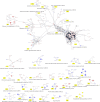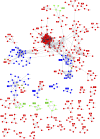Temporal and sequential order of nonoverlapping gene networks unraveled in mated female Drosophila
- PMID: 34844981
- PMCID: PMC8645335
- DOI: 10.26508/lsa.202101119
Temporal and sequential order of nonoverlapping gene networks unraveled in mated female Drosophila
Abstract
In this study, we reanalyzed available datasets of gene expression changes in female Drosophila head induced by mating. Mated females present metabolic phenotypic changes and display behavioral characteristics that are not observed in virgin females, such as repulsion to male sexual aggressiveness, fidelity to food spots selected for oviposition, and restriction to the colonization of new niches. We characterize gene networks that play a role in female brain plasticity after mating using AMINE, a novel algorithm to find dysregulated modules of interacting genes. The uncovered networks of altered genes revealed a strong specificity for each successive period of life span after mating in the female head, with little conservation between them. This finding highlights a temporal order of recruitment of waves of interconnected genes which are apparently transiently modified: the first wave disappears before the emergence of the second wave in a reversible manner and ends with few consolidated gene expression changes at day 20. This analysis might document an extended field of a programmatic control of female phenotypic traits by male seminal fluid.
© 2021 Pasquier et al.
Conflict of interest statement
The authors declare that they have no conflict of interest.
Figures












Similar articles
-
Transcriptional and epigenetic responses to mating and aging in Drosophila melanogaster.BMC Genomics. 2014 Oct 23;15(1):927. doi: 10.1186/1471-2164-15-927. BMC Genomics. 2014. PMID: 25344338 Free PMC article.
-
A genome-wide analysis of courting and mating responses in Drosophila melanogaster females.Genome. 2004 Oct;47(5):900-10. doi: 10.1139/g04-050. Genome. 2004. PMID: 15499404
-
Mating alters gene expression patterns in Drosophila melanogaster male heads.BMC Genomics. 2010 Oct 11;11:558. doi: 10.1186/1471-2164-11-558. BMC Genomics. 2010. PMID: 20937114 Free PMC article.
-
Mating induces developmental changes in the insect female reproductive tract.Curr Opin Insect Sci. 2016 Feb;13:106-113. doi: 10.1016/j.cois.2016.03.002. Epub 2016 Mar 11. Curr Opin Insect Sci. 2016. PMID: 27436559 Review.
-
Seminal fluid-mediated fitness traits in Drosophila.Heredity (Edinb). 2001 Nov;87(Pt 5):511-21. doi: 10.1046/j.1365-2540.2001.00961.x. Heredity (Edinb). 2001. PMID: 11869341 Review.
Cited by
-
A network embedding approach to identify active modules in biological interaction networks.Life Sci Alliance. 2023 Jun 20;6(9):e202201550. doi: 10.26508/lsa.202201550. Print 2023 Sep. Life Sci Alliance. 2023. PMID: 37339804 Free PMC article.
-
Viruses in Laboratory Drosophila and Their Impact on Host Gene Expression.Viruses. 2023 Aug 31;15(9):1849. doi: 10.3390/v15091849. Viruses. 2023. PMID: 37766256 Free PMC article.
-
From whole bodies to single cells: A guide to transcriptomic approaches for ecology and evolutionary biology.Mol Ecol. 2025 Aug;34(15):e17382. doi: 10.1111/mec.17382. Epub 2024 Jun 10. Mol Ecol. 2025. PMID: 38856653 Free PMC article. Review.
-
Time series transcriptome analysis implicates the circadian clock in the Drosophila melanogaster female's response to sex peptide.Proc Natl Acad Sci U S A. 2023 Jan 31;120(5):e2214883120. doi: 10.1073/pnas.2214883120. Epub 2023 Jan 27. Proc Natl Acad Sci U S A. 2023. PMID: 36706221 Free PMC article.
References
Publication types
MeSH terms
Substances
LinkOut - more resources
Full Text Sources
Molecular Biology Databases
